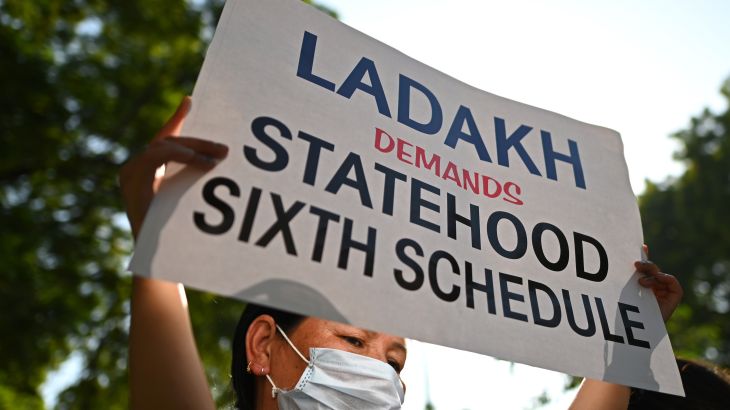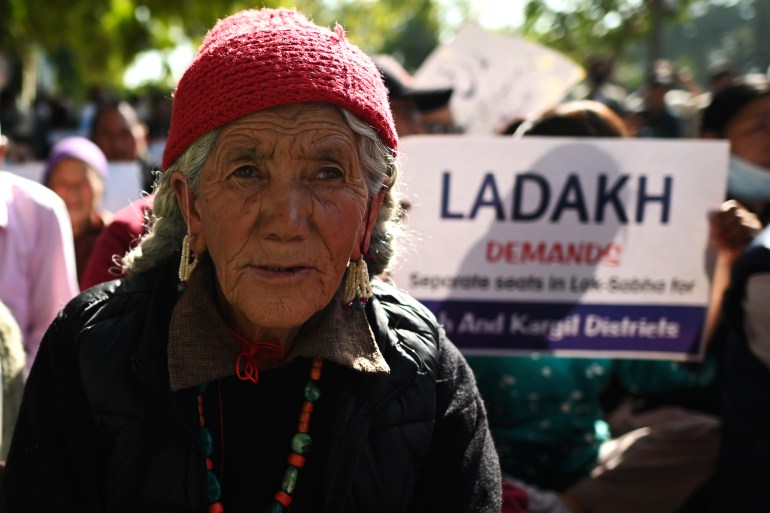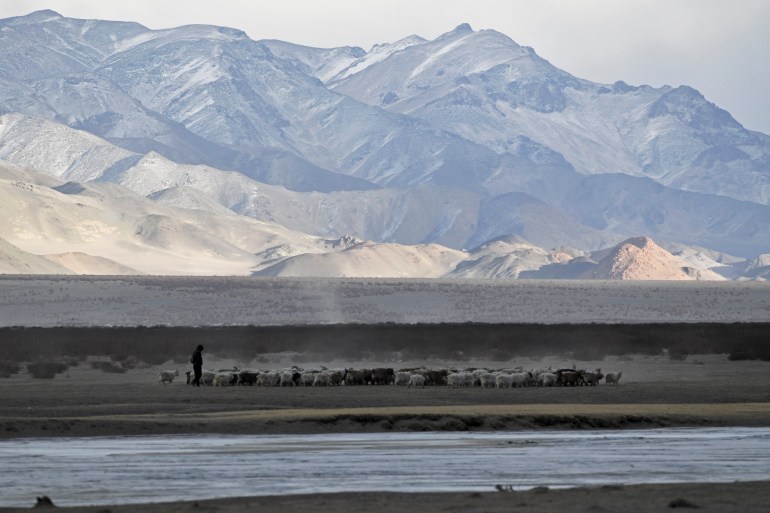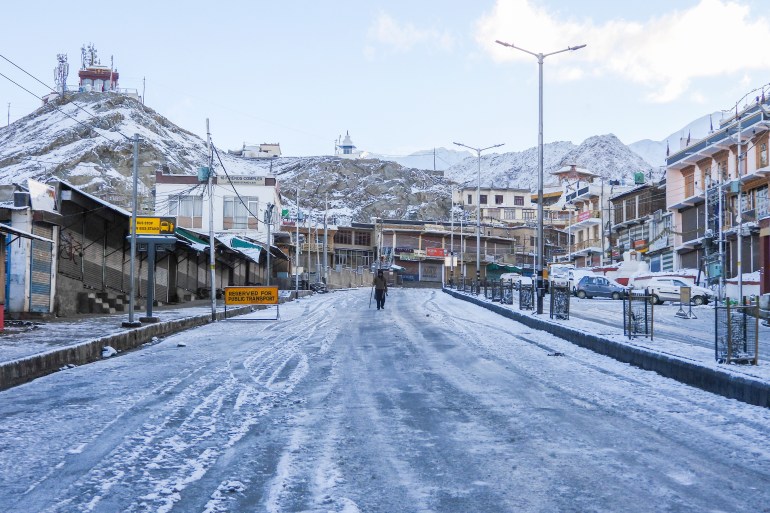Why India’s Ladakh region is now fighting for full statehood
Three years after Ladakh was separated from Indian-administered Kashmir, residents say they want more safeguards for land and livelihoods.

On August 5, 2019, when Ladakh was separated from Indian-administered Kashmir and turned into a federally governed territory, the streets in its main city – the Buddhist-majority Leh – erupted in jubilation.
Nearly 300,000 residents in the Himalayan desert – situated 5,730 metres (18,800 feet) above sea level – had hoped the ruling Bharatiya Janata Party’s (BJP) move would safeguard their lands and livelihoods.
Keep reading
list of 4 itemsLadakh Buddhists who hailed India’s Kashmir move not so sure now
Ladakhi nomads along tense India-China border struggle to survive
Photos: Ladakh herders struggle on the frontier of climate crisis
More than three years later, that hope has been replaced by anger and desperation.
Residents now fear Ladakh’s fragile ecology will be threatened by developmental and industrial projects approved in New Delhi without their consent. They are also concerned that people from other parts of India would settle there, thereby changing the mainly tribal demography of the region.
On Wednesday, a group of Ladakh’s political leaders, civil society members and students travelled nearly 1,000km (621 miles) to the national capital of New Delhi to demand their rights.
“We protested in Ladakh and Jammu earlier but nobody listened to us. That is why we have come to Delhi so that the government can hear our voice,” student Zahida Banoo told Al Jazeera, as she protested at New Delhi’s Jantar Mantar, less than a kilometre from India’s parliament.

The protesters want Ladakh to be declared a separate state, and their jobs and land rights protected.
“Our lands were protected, our jobs were protected, and now we are totally exposed to outside influence. In that way, we were much better. We wanted separation of Ladakh from Jammu and Kashmir but we didn’t want it this way,” Ladakhi politician Chering Dorjay told Al Jazeera.
When Ladakh was part of Indian-administered Kashmir, the Ladakh Autonomous Hill Development Council (LAHDC), an elected body that governed the region, enjoyed significant autonomy. But with the region now under the direct rule of New Delhi, Ladakhi leaders say the LAHDC has been reduced to footnotes, leading to a feeling of political dispossession.
‘Ladakh could become another Tibet’
Sonam Wangchuk was one of the prominent Ladakhis who in 2019 endorsed the BJP’s decision to strip Indian-administered Kashmir of its autonomy and turn Ladakh into a separate union territory.
Wangchuk is an engineer, innovator and climate activist whose life is said to have inspired the 2009 Bollywood blockbuster, 3 Idiots.
Last month, as part of a symbolic protest, Wangchuk slept under the open sky for five nights in minus 25 degrees Celsius (-13 Fahrenheit) temperatures to demand constitutional safeguards for the residents of the sparsely populated region.

Wangchuk is seeking more autonomy for Ladakh as people have apprehensions India could turn Ladakh into another Tibet.
“Tibet has been completely raped of all kinds of minerals and so on,” he told Al Jazeera, referring to the region’s control by China.
Wangchuk says if Ladakh does not get land safeguards, Ladakhis will become a minority in their own land.
“In Tibet, there are hardly any Tibetans now. It is mostly people from mainland China and Tibetans are a minority in their own place. They have no rights,” he told Al Jazeera.
“People in Ladakh do fear that if there are industries, each industry will bring lakhs of people and this fragile ecosystem cannot support so many people.”
According to the officials, several industrial groups have shown interest in exploring Ladakh for the development of infrastructure and mining, making the residents restless.
Surrounded by barren and snow-peaked mountains, Ladakh is home to multiple glaciated lakes and many small and big glaciers. Studies have shown that the glaciers in the region are receding at a fast pace due to climate change.
“If industries come, all these glaciers will be gone. We will immediately become climate refugees,” Wangchuk said.
Sixth Schedule
One of the main demands of the people in Ladakh is their inclusion in the Sixth Schedule of India’s constitution. The schedule protects areas with tribal and Indigenous populations by extending Article 371 of the constitution, and is effective in four states in India’s northeast.
Ladakh residents say they are also eligible for similar protection since 97 percent of their region is tribal.
“We were very happy that Ladakh will be now managed the way it is,” Wangchuk said, referring assurances given by the government three years ago.
“When Ladakh became a union territory, we were assured that we will get some safeguards. We were sure that we will get a legislator and the Sixth Schedule that will give us the safeguards.
“But now, three years have passed and they are not even talking about it. Even reminding them of their promise has become like a crime,” a soft-spoken Wangchuk told Al Jazeera.
Ladakh is comprised mainly of two districts – the mainly Buddhist Leh and Muslim-majority Kargil. The recent protests have united the two districts traditionally divided along religious and political lines.

Community leaders from the two districts have formed Leh Apex Body (LAB) and Kargil Democratic Alliance (KDA) to take forward the concerns of the people.
Article 370 of the Indian constitution, which the BJP government abrogated in 2019, barred outsiders from permanent settlement or setting up businesses in Indian-administered Kashmir, of which Ladakh was a part. Jobs and academic scholarships were also exclusively meant for the region’s permanent residents.
All those rights are gone now, adding to the fears and anger in the Himalayan region that borders both China and Pakistan.
The government has formed a committee to look into the demands of the protesters. But Ladakh’s community leaders say they will take part in talks with the panel if their core demands are put on the agenda.
‘Demographic change’
In Kargil, 216km (134 miles) from Leh, people say they had been resisting the 2019 division of Indian-administered Kashmir, which “erased their political representation”.
KDA member Sajjad Kargili told Al Jazeera that people have a real fear of demographic change now. “We are a microscopic population. Even if 20,000 people from outside come, it would be a worry for us.”
Leh resident Jigmet Paljor, who is a member of LAB, echoed similar views and said residents are concerned over the shifting of economic and political powers to New Delhi.
“The participative democracy is not there. All major decisions are taken by the federal government or by the governor. Our representation has no political powers,” Paljor said.
“Our message is clear, we want the government to listen to us.”
Kashmir-based academic and political analyst Siddiq Wahid said many factors are driving the protests in Ladakh.
“The greatest factor is that the union territory they sought and received has resulted in greater centralisation rather than more autonomy,” he told Al Jazeera.
But the ruling BJP says Ladakh does not need full statehood to protect its residents.
“Nobody has come to settle here, this is just a rumour by the opposition to mislead people of Ladakh. No demographic change has taken place so far and this will not happen,” BJP spokesman PT Kunzang told Al Jazeera.
Radha Kumar, a New Delhi-based academic expert on Kashmir, said people in Ladakh are feeling alienated by the current government.
“They (Ladakhis) had always been pro-integration with the rest of the country which distinguishes them from Kashmir. But they feel their hopes have been dashed,” she told Al Jazeera. “That is why they want statehood. Then they will have their own elected government that will do something for them.”